Author’s note June 28, 2022: Since Sightline published this article, the Trudeau Cabinet and Canada’s independent budget watchdog, the Parliamentary Budget Office (PBO), have released new information further demonstrating the shaky financial standing of the Trans Mountain Pipeline expansion project. In May 2022, Finance Canada announced a Can$10 billion loan guarantee from the federal government, intended to attract private financing for the remaining construction costs, despite promising no further public funding for the project in February of this year. In June 2022, the PBO conducted an updated financial analysis of the Trudeau administration’s decision to purchase the pipeline and found that Canadians will lose an estimated Can$600 million on the project due to its ballooning costs and construction delays. That loss estimate is likely low: PBO found if shippers pay tolls equal to the cost of service after their current contracts expire in 2044, rather than current contracts being renewed with their current terms, Canadians’ net loss would rise to an estimated Can$2.7 billion. If costs increase further or the project is further delayed, Canada’s losses will mount.
On February 18, 2022, the Canadian government-owned Trans Mountain Corporation revealed that the controversial Trans Mountain Pipeline Expansion (TMX) project is delayed yet again and will now cost Can$21.4 billion. This is a whopping four times the original Can$5.4 billion cost estimate offered by then-owner Kinder Morgan when it first proposed the project a decade ago.
The project, which is about 50 percent complete, will “twin” the existing Trans Mountain pipeline, transporting some of the world’s dirtiest oil from the tar sands in Alberta across British Columbia to Burnaby, BC. From there, it will be loaded onto oil tankers and shipped for export through the Salish Sea along BC and Washington coastlines. If completed, the project will triple the capacity of the existing pipeline, reaching a total capacity of about 890,000 barrels per day, more than the recently cancelled Keystone XL pipeline would have carried.
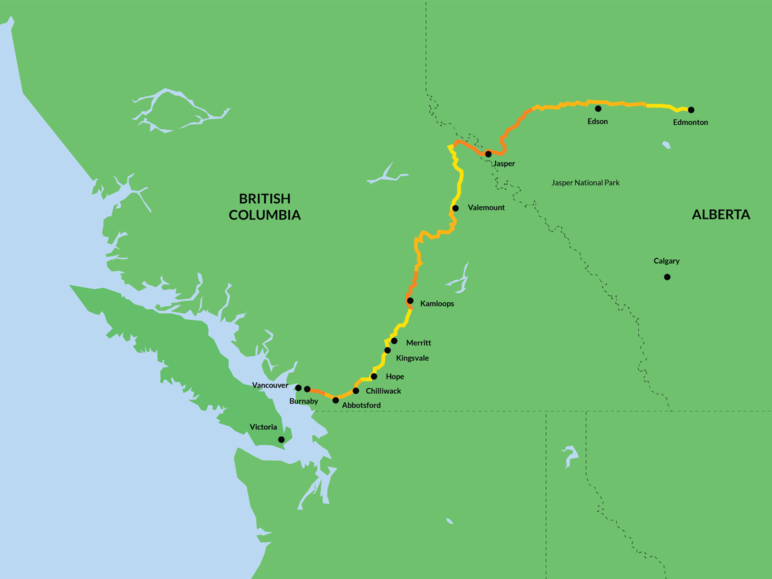
What is the Trans Mountain Expansion Project? by Government of Canada (Map of the approved expansion of the Trans Mountain Pipeline. This map shows the route of the Trans Mountain Pipeline Expansion Project from just east of Edmonton, Alberta, to Burnaby, British Columbia.)
Since Kinder Morgan first proposed the project in 2012, it has faced multiple lawsuits and staunch opposition from dozens of First Nations and Indigenous groups, environmental organizations, and local governments in both Canada and the United States. As we make sense of this latest announcement, and as oil industry boosters are using the Russian invasion of Ukraine to promote building more Canadian oil pipelines, it’s worth revisiting why Prime Minister Justin Trudeau should cancel the project—indeed should have canceled it years ago. We count at least five big reasons:
1. Canadians stand to lose billions from the project
Although the business case for the pipeline has always been shaky, the latest cost increase confirms that the pipeline has turned into a giant money pit, putting the Canadian public’s dollars at risk.
Trudeau’s government bought the existing pipeline and the expansion project as a buyer of last resort in 2018 for Can$4.5 billion from US-based pipeline giant Kinder Morgan after it walked away in the face of mounting delays, costs, and opposition. The prime minister promised that after construction was complete, his administration would sell the pipeline for a profit and use the proceeds to fund the country’s clean energy transition. Minister of Finance Chrystia Freeland repeated this claim after the February 18th announcement.
Some First Nations along the pipeline’s route have expressed interest in a full or partial ownership stake of the pipeline, while dozens of others, including the Squamish Nation and the Tsleil-Waututh Nation have steadfastly opposed the project and challenged it multiple times in court. As Geraldine Manson, Elder of the Snuneymuxw First Nation, who opposes the pipeline, told Sightline, “The government is not listening to First Nations. If they are going to a First Nation community and offering them dollars they need, of course they will take those…. We can’t judge the community for having no infrastructure and no dollars to survive for their future.”
However, the new Can$21.4 billion cost estimate makes abundantly clear that if the Trudeau administration completes and sells the pipeline, it will be at a stupendous loss, not at a profit. As Omar Mawji, energy analyst at the Institute for Energy Economics and Financial Analysis (IEEFA), told Sightline, “I don’t know who will purchase it unless it’s at a huge discount.” Indeed, Canada’s Parliamentary Budget Officer Yves Giroux told Canada’s National Observer that he is “not hopeful that there will be any profits to be made from that pipeline, at least for the federal government.”
Losses are inevitable because the tolls that oil producers, also known as shippers, will pay Trans Mountain to use the pipeline do not and cannot cover the full capital cost of the project. As the orange bars on the chart below show, since Kinder Morgan first proposed the expansion project, capital costs have increased from Can$5.4 billion to Can$7.4 billion to Can$12.6 billion, and as of the latest announcement, are now estimated at Can$21.4 billion. But the Canada Energy Regulator (CER) has not revised tolls upwards since Kinder Morgan set them in 2017 based on the then-Can$7.4 billion cost estimate. Even worse, the toll agreements set between Kinder Morgan and the shippers stipulated that just 25 percent of cost overruns can be recovered in toll revenue. These contracts mean that in a best-case scenario, Can$10.9 billion of capital costs1 can be covered by shipping revenues, indicated by the green dotted line on the chart below. The other half of the estimated Can$21.4 billion Canada will have spent by the time the pipeline is finished, if costs don’t rise further? Ottawa will have to eat that Can$10.5 billion loss. No wonder committed shippers like Cenovus and Suncor seem unfazed by the ballooning costs: none of the extra bill falls to them.
Pipeline supporters may point out that Finance Minister Freeland also announced in her statement that “the government will spend no additional public money on the project.” At first glance, those words suggest that private investors will cover rising costs. But as economists have pointed out, a private lender would not finance the project without a backstop from Ottawa. Despite what Freeland says, the Canadian public will still be on the hook.
2. The amount not yet spent could more than double Canada’s existing solar capacity
The ballooning costs beg the obvious question of whether continuing to sink money into expanding a massive oil pipeline is the best use of public dollars, especially in the face of an ever-worsening climate crisis. To date, Trans Mountain has spent an estimated Can$9.9 billion on the project, meaning about Can$11.5 billion remains to be spent. When Trudeau’s administration reapproved the pipeline in 2019, Trudeau promised that “every dollar the federal government earns from this project will be invested in Canada’s clean energy transition.” As outlined above, it’s looking like the dollars that Canada will earn from this project are going to be zero.
Let’s say instead that the Trudeau government decided to cut its losses, cancel the pipeline, and spend the remaining Can$11.5 billion on clean energy. As indicated by the chart below, a rough estimate suggests Canada could spend that amount and more than double its existing solar capacity from the approximately 3,000 MW installed today to nearly 8,000 MW. That would be enough to power approximately 1.6 million homes, or 11 percent of all homes in the country2—a far better deal for Canadians compared with a dinosaur oil project that will lock the country into further reliance on fossil fuels.
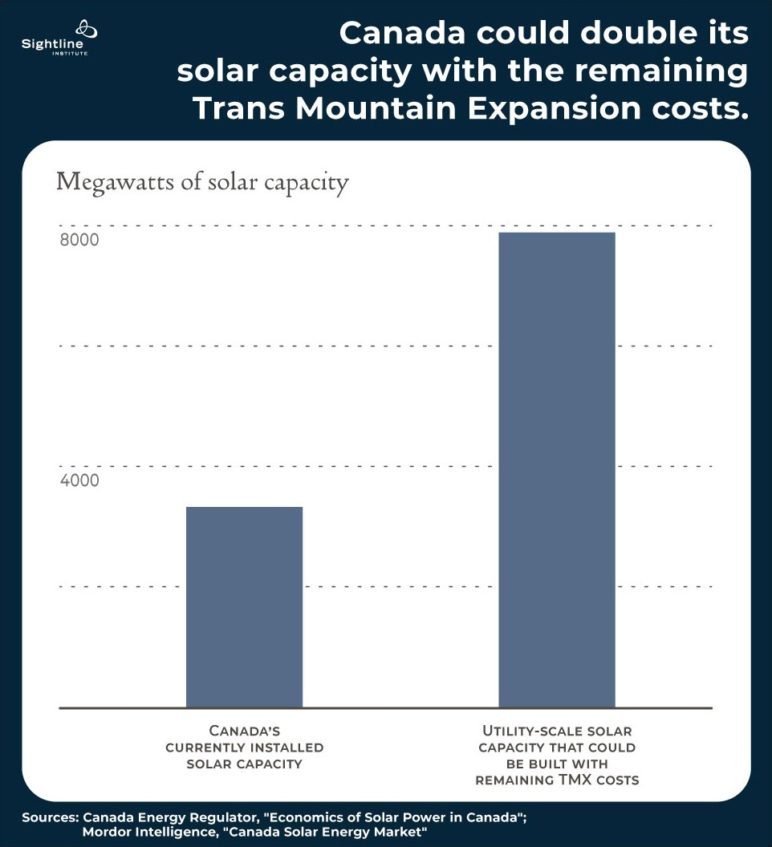
Methodology: Canada Energy Regulator (CER) estimates the cost of utility-scale solar installation is Can$1.458/W. Can$11.5B of remaining project costs divided by Can$1.458 is 7,887MW.
3. Producing the oil to fill the pipeline would release more emissions annually than 125 countries
Not only would Canada be able to better spend its money on clean energy, but also TMX would facilitate an uptick in carbon emissions in Canada by enabling greater oil production: a strange decision for a country that is party to the Paris agreement, has declared itself a climate leader, and has legally committed to achieving net zero emissions by 2050.
The oil that will flow through the Trans Mountain Pipeline is notoriously dirty and carbon-intensive to produce. Indeed, despite reductions in emissions intensity over the last decade, CER estimates that Canada’s oil sands production still releases an estimated 80 kilograms per barrel, compared to a global average across all oil of about 18 kilograms per barrel. Using these figures, just producing the oil to fill TMX to capacity would release the equivalent of at least 15 million metric tons of CO2 annually. That’s more than the annual emissions of 125 countries, including Panama, Senegal, Uruguay, and Tanzania. And this comparison only tallies emissions from the tar-sands extraction process (so-called “upstream production”), not the vast quantities of carbon that will rise into the atmosphere when the tar-sands oil finally burns in a car, truck, or other machine.
Critics may argue that expanding Trans Mountain won’t matter to the climate, because if Canada stops building the pipeline, oil companies will just ship the tar sands some other way, namely by rail. This scenario might be true in the next few months, when sky-high oil prices could justify producers spending on costlier rail transport. But as oil prices stabilize and drop in the medium- to long-term, especially if oil demand declines in accordance with the world’s climate commitments, shipping oil by rail will be too expensive. When that’s the case, whether or not Canada completes TMX will likely determine how much of the Athabascan tar sands become heat-trapping carbon in the atmosphere and how much stays in the ground under the boreal forests of Alberta.
4. The pipeline is excess capacity if we’re to believe Canada’s latest climate pledge
In November, at COP26 in Glasgow, Prime Minister Trudeau said, “We’ll cap oil and gas sector emissions today and ensure they decrease tomorrow at a pace and scale needed to reach net-zero by 2050.” Observers were quick to point out that Trudeau did not commit to capping oil and gas production. But there’s no way to meet this goal without doing so.
To hear leaders of the oil and gas sector tell it, they can reduce emissions while growing oil production: they will use technology that doesn’t exist yet, such as colossal machines that suck carbon out of the air and lock it into minerals or bury it underground. As Terry Abel, Executive Vice President of the Canadian Association of Petroleum Producers (CAPP) said, “we believe we can get to a point in Canada as an industry where we can grow our production of oil and natural gas and actually have overall emissions go down as opposed to increase.”
But producing more oil while emitting less relies on massively scaling technology that’s barely in its infancy today, a “highly uncertain prospect.” The largest direct air capture technology in the world today, for example, sequesters just 0.04 million metric ton of CO2 a year; Canada’s oil sands produce the equivalent of 83 million metric tons of CO2 a year today, or 2,000 times as much.
So if we assume that Canada will make good on its word and cap oil and gas emissions and thus production, does it need the additional pipeline capacity from TMX? In short, no. The chart below using data from the Canada Energy Regulator’s 2021 and 2020 Energy Future reports shows Canada’s existing oil pipeline capacity without TMX in green and its historical and projected oil export production through 2022 in dark blue. Even without oil-by-rail capacity (shown in orange), pipeline capacity exceeds oil production. While some will point out that the capacity just barely exceeds supply today, and that excess capacity allows oil suppliers flexibility to “access higher value markets, and avoid the impacts of maintenance, unforeseen outages, and higher cost rail,” more capacity will free up if and when Canada trims its oil production to achieve its net zero commitment.
Even the oil industry admits Canada already has enough pipeline capacity without TMX to meet production. The Journal of Petroleum Technology announced, “There is no pressing need for more capacity now because [of] last year’s startup of the Enbridge Line 3 replacement.” Industry insider RBN Energy reported something similar but argues that this capacity won’t be enough to meet growing oil sands output, which it predicts will “set new production records this year.” How Prime Minister Trudeau reconciles the oil producers’ bullish claims about future production, which the industry is using to justify TMX, with the commitment he made in Glasgow remains a mystery.
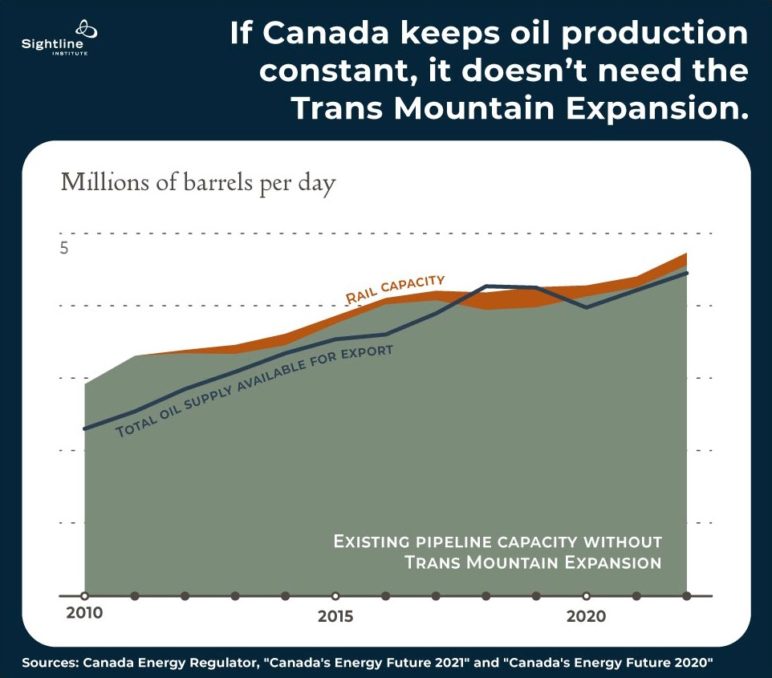
Note on methodology: Total oil supply available for export is based on CER’s 2021 “Current Policies” scenario. Pipeline capacity is estimated by subtracting the 2020 CER rail capacity estimates from the 2021 CER pipeline and rail capacity estimates, since the 2021 report does not disaggregate between pipeline and rail capacity.
5. The Salish Sea will become crowded with oil tankers, a death sentence for orcas
Among the many environmental hazards of the project, one of the most concerning is the risk posed by increased oil tanker traffic to the complex ecosystem of the Salish Sea and to the Indigenous groups who have lived on the Salish Sea since time immemorial. As indicated by the icons of vessels in the figure below, TMX will increase the capacity of Burnaby’s Westridge Marine Terminal to allow it to handle 34 oil tankers a month, up from today’s five. These tankers will thread a path around the San Juan Islands and through the Strait of Juan de Fuca.
In part due to the environmental risk of more oil tankers from the project, Canada’s Federal Court of Appeals overturned the original Canadian approval of the project in Tsleil-Waututh Nation vs. Canada in 2018, citing inadequate consultation with Indigenous groups and a lack of consideration of the adverse environmental impact of the increased oil tanker traffic, particularly on endangered Southern Resident orca whales, whose numbers have now dwindled to just 74.
In response to the Court of Appeal’s ruling, the National Energy Board (NEB) conducted a “reconsideration” of TMX in 2019 focused primarily on the impact of marine vessels on the Salish Sea ecosystem and on Indigenous rights and interests. As part of this reconsideration process, at least 58 Indigenous groups raised concerns about the project, including about the impact of project-related marine shipping on traditional marine resource uses and cultural practices, the risk of an oil spill, and the harm that would be caused to the Southern Resident orcas. Elder Geraldine Manson from the Snuneymuxw First Nation told Sightline about the critical importance that the whales have in her community’s culture: “We have their spirit within. They have such a strong sense of protection of others in the world. As Indigenous people, we understand their legacy of who they are and can connect with them.” She expressed concern that the whales could become disoriented, beach themselves, or become separated from their families if they find themselves in the path of an oil tanker.
Indeed, the NEB reconsideration report found that “the operation of Project-related marine vessels is likely to result in significant adverse effects to the Southern resident killer whales,” among other adverse impacts, due to increase in vessel noise and the risk of a vessel strike. Despite this finding, the NEB recommended the Trudeau government approve the project again. Trudeau obliged. As Eugene Kung, staff attorney at West Coast Environmental Law said, “They said even though it will be bad for climate, bad for Indigenous rights, bad for whales, it will be approved.”
 It’s past time for Trudeau to cancel the pipeline and invest in Canada’s future
It’s past time for Trudeau to cancel the pipeline and invest in Canada’s future
With half the project built, the legal avenues for stopping it largely exhausted, and the Canadian government’s continued support, it may look like the pipeline is a done deal.
But opponents such as Andrew Radzik, Energy Campaigner at the Georgia Strait Alliance in Vancouver, say they aren’t giving up. TMX may still die, he says, “a death of a thousand cuts.” For example, there may not be a private lender willing to step in to cover the remaining costs. Or public support for the project may plummet with the latest news of cost overruns and delays, not to mention the latest dire report from the Intergovernmental Panel on Climate Change (IPCC). Or construction delays may continue to mount, further weakening the business case. Or all of the above. In other words, the project is hardly a forgone conclusion. Indeed, those on the frontline haven’t given up: five protestors in BC, including a 79-year-old woman, were jailed in February for blocking machinery from entering a worksite, in violation of a court injunction against such protests.
At the same time, there is a risk that the oil and gas industry and its supporters will exploit the Russian invasion of Ukraine to justify TMX. Indeed, Alberta’s Premier, Jason Kenney tweeted, “Now if Canada really wants to help defang Putin, then let’s get some pipelines built!” However, as Canada’s Environment Minister Steven Guilbeault and others have pointed out, pipelines take years to build, and a quicker, cleaner, longer-term solution is to reduce Europe’s dependency on oil and gas altogether through an ambitious decarbonization program. Even TMX, which is 50 percent built, won’t likely be operational until 2024, given its latest “mechanical completion” date now delayed yet again to the latter half of 2023. This is hardly soon enough to address any temporary shortage of oil supply resulting from Russia’s invasion of Ukraine.
Rather than waiting for TMX to die that slow death, then, Prime Minister Trudeau would be smart to step in now and cancel it. While it’s difficult and perhaps politically risky to admit a mistake, throwing good money after bad, down a fossil fuel pipe, is even worse: Can$11.5 billion more wasted, mounting climate hypocrisy, further degradation of Indigenous land and rights, the risk of a devastating oil spill along BC and Washington coasts. Not to mention, there is no upside for the immediate relief of Europe’s reliance on Russian oil. The writing is on the wall: the Trans Mountain Expansion Project is not the economic engine it was made out to be a decade ago, nor is it a credible path to Canada’s clean energy future.

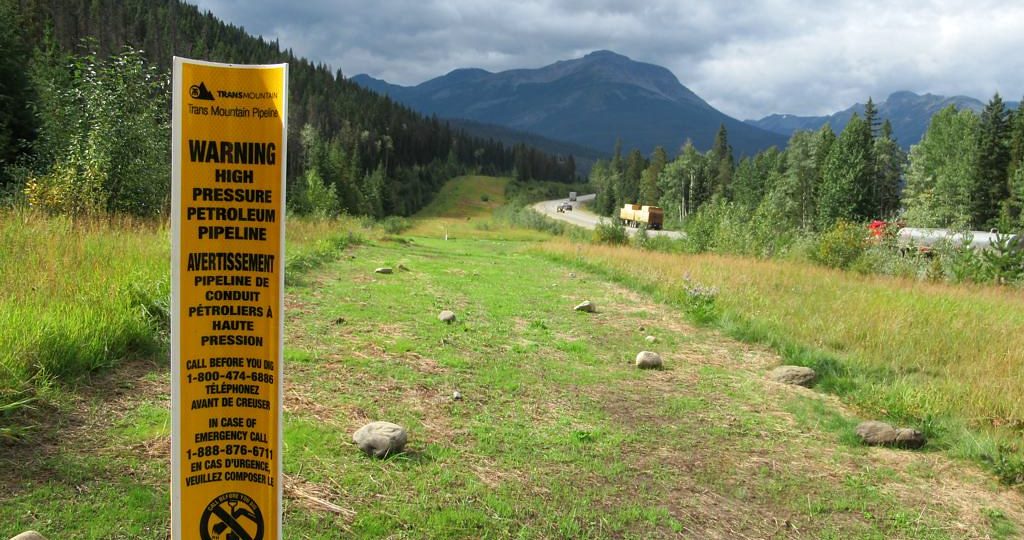
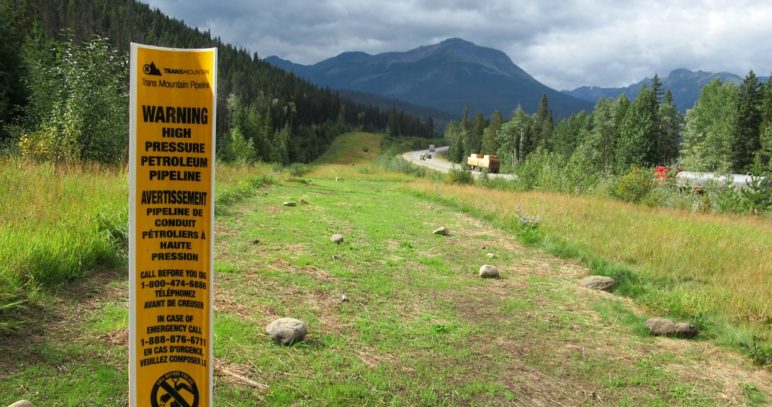

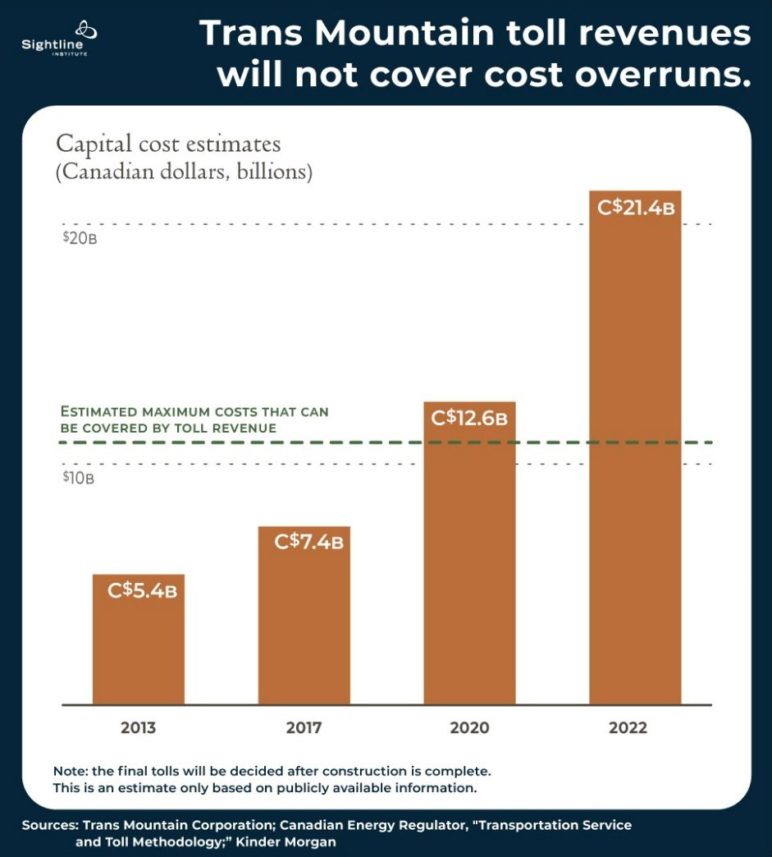
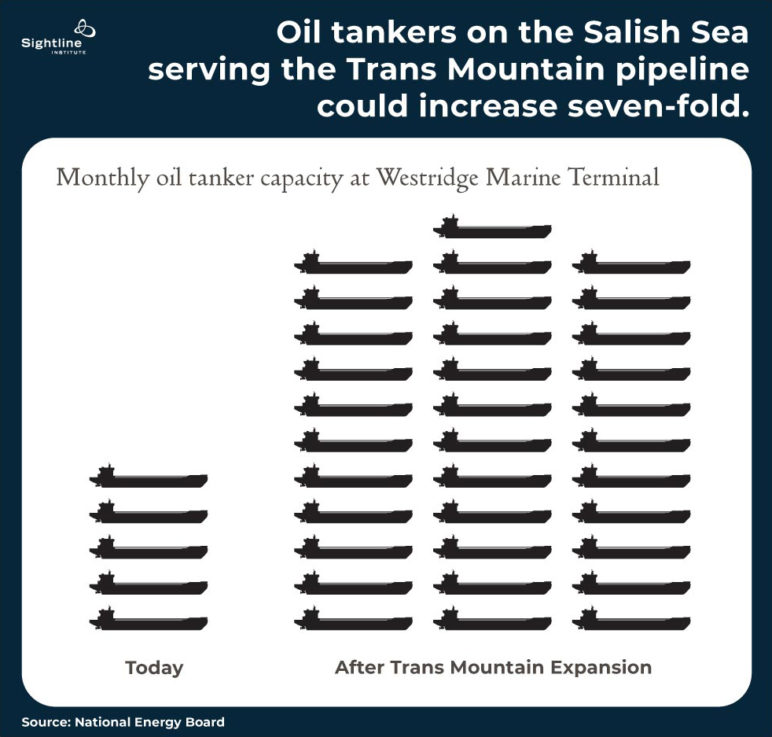 It’s past time for Trudeau to cancel the pipeline and invest in Canada’s future
It’s past time for Trudeau to cancel the pipeline and invest in Canada’s future






Tom
Excellent reporting, well researched, and a tribute to the high standard that Sightline has set for modern journalism. Kudos. Your quote from Eugene Kung says it all; basically, logic doesn’t enter into these decisions. It is pure politics. Fortunately, that gets them in the door but is not enough to sustain the project in the end. Thank you for continuing to out the fiscal illogic of this, so that potential investors and insurers, including First Nations, can see the risk. As you point out, without them, there will be no pipeline.
Earl Richards
The TMX is a stupid idea to begin with, because the Trans Mountain Corporation has no equipment to clean-up a toxic bitumen spill from their pipeline into the Fraser River watershed. A spill will kill most of BC’s sport and commercial salmon industries. Remember the Kalamazoo.
DC
Does the TMX valuation include taxation on increased crude exports? And if Canadian crude is used in lieu of Maya ex Mexico, sold into Asia, it’d more than half shipping transit time and carbon exposure.
Serena Larkin
Thanks for your question, DC. Emily is away from the office until July 18 but will respond to your question then.
Daniel Cater
Many thanks Serena